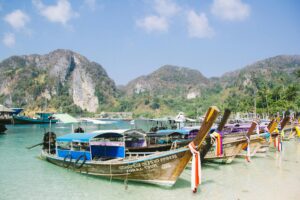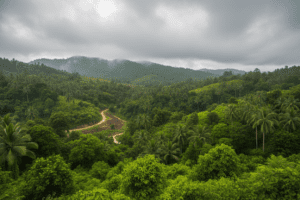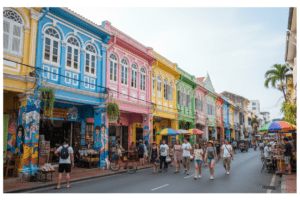🎯 Key Takeaways
- No visa required for most countries (30-day stamp), but passport needs 6+ months validity
- Get comprehensive travel insurance that covers motorbike accidents and water sports
- Dry season (Nov-Apr) is peak time with higher prices; rainy season (May-Oct) offers fewer crowds and better deals
- Use Grab app for transparent taxi pricing and negotiate tuk-tuk fares upfront
- Must-see highlights: Big Buddha, Phi Phi Islands, Old Phuket Town, and Wat Chalong temple
- Budget $30-60/night for accommodation, with street food costing less than restaurant meals back home
- Motorbike rentals are popular but risky – ensure you’re experienced and have proper insurance coverage
📋 Table of Contents
- What to Know Before Visiting Phuket: The Essentials
- Phuket Travel Tips First Time Visitors Absolutely Need
- Phuket for Beginners: Top Sights & Unforgettable Activities
- Building Your Perfect Trip: A Complete Phuket Travel Guide
- The Ultimate Phuket Guide 2025: What’s New and What to Expect
- Frequently Asked Questions (FAQs)
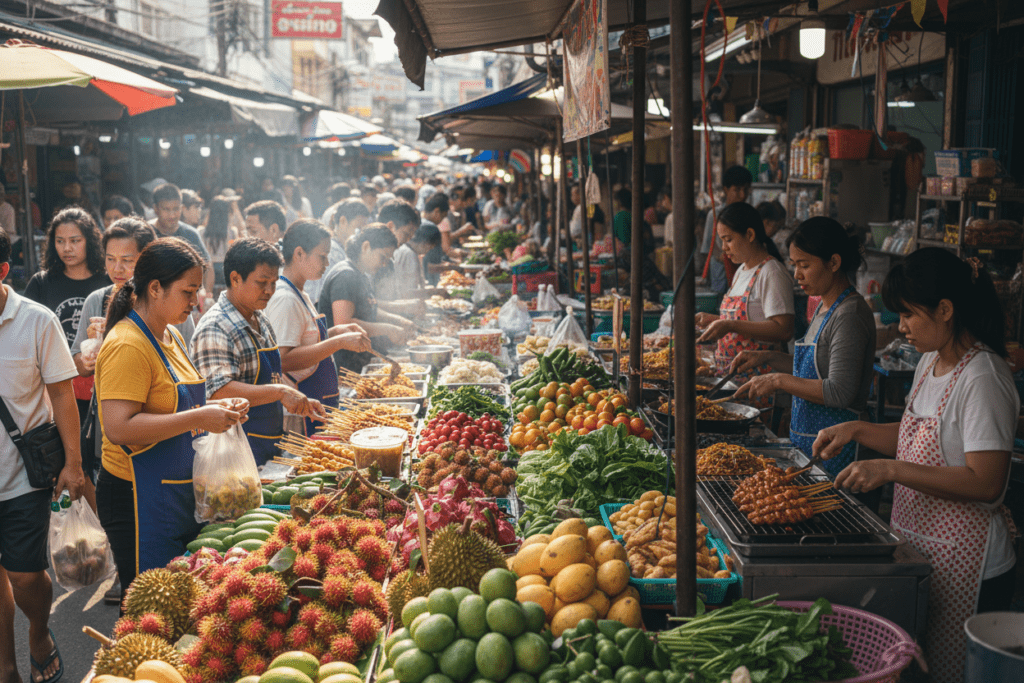
Picture this: you step off the plane into warm, humid air that immediately tells you you’re somewhere special. That’s Phuket for you. If this is your first time visiting Phuket, you’re honestly in for something incredible. Thailand’s largest island hits different than anywhere else I’ve been – it’s got these crystal-clear beaches that look fake they’re so perfect, street markets bursting with smells and colors that’ll overwhelm your senses in the best way, and this rich cultural tapestry that somehow makes sense of the beautiful chaos.
The thing about Phuket is its ridiculous diversity. You could spend your morning meditating at a Buddhist temple, your afternoon learning to surf, and your evening dancing on tables in Patong. Or you could do absolutely none of that and just read a book on Mai Khao Beach while turtles nest nearby. Learn more about Phuket’s attractions on Nomadic Matt’s travel guide.
This complete Phuket travel guide is basically everything I wish someone had told me before my first trip. We’re covering the pre-trip essentials that’ll save you headaches, money-saving tricks that actually work, the sights you absolutely can’t miss, and those little insider tips that make the difference between a good trip and an unforgettable one.
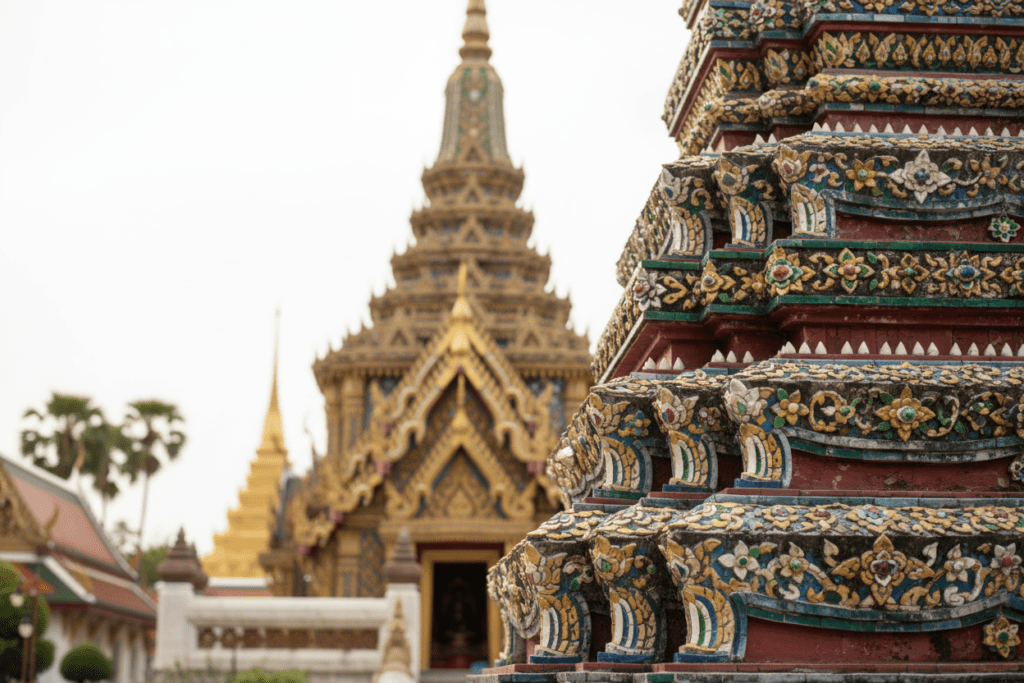
What to Know Before Visiting Phuket: The Essentials
Here’s the stuff that really matters when you’re figuring out what to know before visiting Phuket. Skip this section at your own risk – I learned some of these lessons the hard way.
Visa Requirements & Entry Rules
The visa situation is surprisingly straightforward. Most people from major countries can just show up and get stamped in for 30 days. No advance paperwork, no stress.
But here’s the crucial bit that catches people out: your passport needs at least six months of validity left from when you enter. Not three months, not “eh, close enough” – six full months. Immigration officers will turn you away if you don’t meet this requirement, and trust me, you don’t want to find this out at Bangkok airport.
If you’re planning to stay longer or want to be extra safe, you can grab a tourist visa from a Thai embassy before you travel. Check the latest visa requirements on Nomadic Matt’s Thailand guide.
Health, Safety & Insurance
Good news on the health front – there are zero mandatory vaccinations to enter Thailand. That said, being up-to-date on your routine shots is smart, and most travel doctors will recommend Hepatitis A and Typhoid vaccines if you’re planning to eat a lot of street food (which you absolutely should).
But here’s what I cannot stress enough: get comprehensive travel insurance. Not the basic “covers medical emergencies” kind, but the full coverage that includes motorbike accidents and water sports. Phuket has this weird way of making everyone feel invincible, right up until they’re not. For details on insurance tiers and what each covers, check out our Motorbike Rental Insurance Thailand: 4 Tiers & 5,000 THB.
Phuket is generally super safe. The biggest risks are honestly your own decisions – like renting a scooter when you’ve never driven one, or swimming when the red flags are up. Petty theft happens in crowded areas, but it’s more annoying than dangerous.
Best Time to Visit
This is where it gets interesting. Phuket has two very different personalities depending on when you visit.
Dry Season (November – April) is peak time. You get those postcard-perfect sunny days with minimal rain, which makes it ideal for beach bumming and island hopping. But you’ll pay for the privilege – flights cost more, hotels jack up their rates, and every beach looks like a travel brochure came to life.
Rainy Season (May – October) is when things get real. Yes, it rains more, but it’s not like you’re trapped indoors for months. The rain usually comes in dramatic afternoon downpours that are actually kind of amazing to watch. Plus, you get way fewer crowds and prices drop significantly. If you don’t mind dodging the occasional storm and can handle a bit of humidity, this can actually be the better time to visit. Read more about Phuket’s weather patterns here.
Currency, Tipping, and Local Customs
The local currency is Thai Baht (THB), and you’ll get used to the exchange rate pretty quickly. ATMs are everywhere, and most places take cards, though street vendors prefer cash.
Tipping isn’t expected like it is in the US, but it’s definitely appreciated. In restaurants, 10% for great service is generous. For taxis and tuk-tuks, just round up to the nearest convenient number. It’s more about showing appreciation than following strict rules.
The etiquette stuff is pretty straightforward but important. Cover your shoulders and knees when visiting temples – this isn’t negotiable. Always remove your shoes before entering homes and religious buildings. Show respect to monks and elderly people. And learn the “wai” greeting – palms together like you’re praying, with a slight bow. It’s not required for tourists, but locals love it when you make the effort. Get more cultural tips from this comprehensive guide.
Phuket Travel Tips First Time Visitors Absolutely Need
These Phuket travel tips first time visitors need aren’t the obvious ones you’ll find everywhere. They’re the ones that’ll actually make your trip smoother.
The Ultimate Packing Checklist
Essentials you can’t compromise on: High SPF sunscreen (and lots of it – the sun here is no joke), industrial-strength mosquito repellent, lightweight breathable clothing because the humidity is real, a light rain jacket even in dry season, multiple swimsuits because nothing dries completely in this humidity, and a proper wide-brimmed hat plus decent sunglasses.
Tech stuff that matters: A universal travel adapter because Thailand uses a mix of plug types A, B, C, and F – basically, it’s a grab bag. A portable power bank is essential for those long beach days when you’re taking way too many photos. And get a waterproof phone pouch. Trust me on this one – between beach spray, boat trips, and sudden downpours, your phone needs protection.
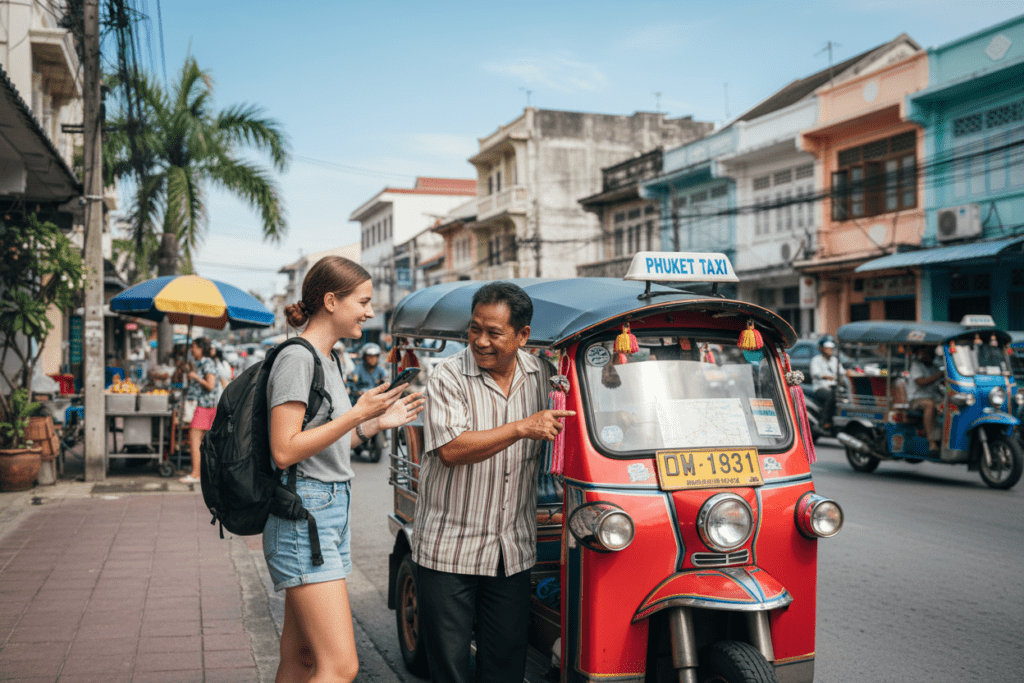
Navigating Phuket: Your Transport Options
Tuk-tuks are those adorable three-wheeled vehicles you see in every Thailand photo. They’re perfect for short distances and give you that authentic feel. The key thing: negotiate and agree on the price before you even sit down. No exceptions.
Taxis and ride-hailing get tricky because metered taxis basically don’t exist outside the airport. Regular taxis will try to negotiate a flat rate, which can work but requires some back-and-forth. Your best bet is using Grab (Thailand’s Uber equivalent) because the pricing is transparent and you don’t have to negotiate anything. Learn more about transport options from Nomadic Matt.
Motorbike rentals are incredibly popular and cheap, but I need to be real with you here – they’re also risky as hell. Many accidents involve tourists who underestimate the traffic chaos or overestimate their riding skills. If you do rent one, helmets are legally required, make sure your travel insurance covers it, and please be an experienced rider before you attempt Phuket’s roads. For a complete guide to exploring Phuket by motorcycle, check out our Discovering Phuket: The Ultimate Road Trip Adventure. Also, for general tips on renting scooters and saving money, see our Motorbike Rental Thailand Guide: Scooters from 150 THB/Day and don’t forget to do a quick pre-ride inspection with our Motorbike Rental Checklist Thailand: 5-Minute Inspection. And if you want the peace of mind of a well-maintained bike with clear insurance and proper gear, consider renting through Byklo.rent.
Ferries and longtail boats are your gateway to island hopping. These are essential for getting to famous spots like Phi Phi Islands or James Bond Island. The boats range from basic longtails to fancy speedboats, depending on your budget and tolerance for adventure.
Money-Saving Hacks
Bargaining is expected in markets and for non-metered transport. Don’t go crazy with it, but polite negotiation is part of the culture. Start at about 60% of their first price and work from there.
Street food is where you’ll eat the best meals for the least money. Those hole-in-the-wall places and food courts serve incredibly authentic dishes for a fraction of restaurant prices. A full meal can cost less than a coffee back home.
Happy hour deals are everywhere, especially in Patong and Kata. Many bars and restaurants offer buy-one-get-one deals or significantly reduced prices between 4-7 PM. Check out more budget tips here.
Staying Safe: Scams and Beach Rules
Learn the beach flag system immediately. Red flags mean absolutely no swimming due to dangerous currents, which is especially common during monsoon season. I’ve seen too many tourists ignore these warnings.
Common scams include jet ski rental operators claiming you damaged their equipment (take photos before and after), overpriced taxi rides (use Grab when possible), and unsolicited tour offers that seem too good to be true (they usually are).
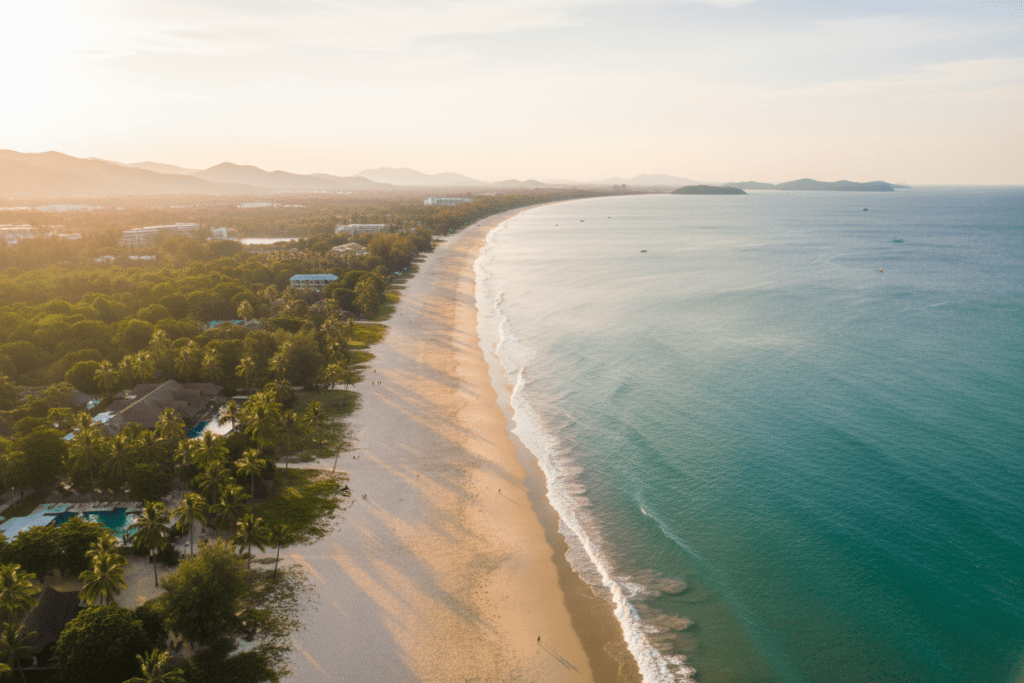
Phuket for Beginners: Top Sights & Unforgettable Activities
If you’re approaching Phuket for beginners, these are the experiences that’ll give you the full island flavor without overwhelming you.
The Must-See Beaches for Every Vibe
Patong Beach is the island’s poster child – busy, energetic, and impossible to ignore. This is where you go for lively nightlife, every water sport imaginable, and that classic “I’m in Thailand” beach scene. It’s crowded, sometimes overwhelmingly so, but there’s an energy here that’s infectious. Read more about Patong on Nomadic Matt’s guide.
Kata and Karon Beaches offer a completely different vibe. They’re more family-friendly with gorgeous white sand that’s perfect for swimming and learning to surf. You get the beach experience without feeling like you’re in the middle of a constant party. The water here is usually calmer, and there’s space to actually relax.
Mai Khao Beach is for when you want to pretend you discovered a secret. It’s part of Sirinat National Park, which means development is limited and the beach stays relatively pristine. This is also a turtle nesting site, so if you time it right during nesting season, you might witness something pretty incredible. Learn more about Phuket’s quieter beaches here.
Essential Cultural Highlights
The Big Buddha is that massive 45-meter white marble statue you can see from all over the island. It sits on top of Nakkerd Hill, and the views from up there are absolutely insane – 360-degree panoramas that make you understand why people fall in love with this place. Go at sunset if you can manage it.
Old Phuket Town is where the island’s history lives. The colorful Sino-Portuguese architecture tells the story of Phuket’s trading past, and now it’s full of trendy indie cafes, incredible street art, and shops selling everything from vintage clothes to handmade jewelry. It’s perfect for wandering when you need a break from beach time. Explore Old Phuket Town details here.
Wat Chalong is Phuket’s largest and most important Buddhist temple complex. The architecture is stunning, with intricate details and beautiful pagodas that are genuinely peaceful to explore. Even if you’re not particularly religious, there’s something calming about the place.
Unforgettable Island-Hopping Day Trips
Phi Phi Islands became world-famous after “The Beach” was filmed there, and honestly, the hype is justified. The lagoons are perfect for snorkeling, and Maya Bay (when it’s open – they close it periodically for environmental recovery) is genuinely stunning. Just expect crowds, especially during peak season.
Phang Nga Bay and James Bond Island offer some of the most dramatic scenery you’ll ever see. Those limestone karsts rising straight out of emerald-green water look like something from a fantasy movie. The whole area feels otherworldly, and boat trips here usually include kayaking through hidden lagoons.
Similan Islands are for serious diving and snorkeling enthusiasts. The coral reefs here are world-class, and the water visibility is incredible. They’re only accessible from mid-October to mid-May due to national park protections, so plan accordingly. Get more island-hopping information here.
Building Your Perfect Trip: A Complete Phuket Travel Guide
This complete Phuket travel guide section is about turning all that information into an actual trip that makes sense.
Sample Itineraries for 3, 5, and 7 Days
3 Days: Keep it simple. Pick one main beach area like Patong or Kata as your base. Spend one full day just enjoying beach life and getting your bearings. Use day two for the Big Buddha and exploring Old Phuket Town in the afternoon. Day three, hit up a night market and maybe catch sunset at a viewpoint.
5 Days: Take everything from the 3-day plan and add a full-day island-hopping tour. Phi Phi Islands or Phang Nga Bay are your best bets. This gives you time to recover from the boat trip and still enjoy more beach time.
7 Days: Now you can really explore. Add Phuket’s quieter northern beaches, visit a national park, and treat yourself to a proper spa day. You might even have time for both major island trips – Phi Phi and James Bond Island.
For longer itineraries, having reliable transport becomes crucial. Renting a motorbike gives you the freedom to explore at your own pace and discover hidden beaches or local restaurants off the beaten path. A service like Byklo.rent can arrange a quality vehicle for your entire stay, which is especially helpful for 5-7 day trips.
Where to Stay: Accommodation by Budget and Area
Budget ($30–$60/night): Hostels and guesthouses are everywhere in Patong and Phuket Town. The quality varies wildly, so read recent reviews carefully. Some budget places are gems with great locations, while others are basically just a bed in a noisy area.
Mid-Range ($70–$150/night): This is the sweet spot for most people. Boutique hotels in Kata, Karon, and Kamala offer good value with nice amenities like pools and decent breakfast. Old Phuket Town has some beautiful restored buildings turned into stylish hotels.
Luxury ($200+): Phuket does luxury well. Private villas and 5-star resorts along quieter beaches like Surin and Mai Khao offer incredible experiences. Some of these places are destinations in themselves. Check accommodation pricing on Nomadic Matt.
A Foodie’s Guide to Phuket
Street food is where Phuket’s soul lives. Pad Thai from a cart tastes different (better) than from a restaurant. Banana pancakes (roti) are perfect for breakfast or late-night snacking. Fresh fruit smoothies made to order are incredibly cheap and refreshing. And the grilled seafood at night markets is an experience you can’t replicate anywhere else.
Dining experiences range from casual beachfront seafood places where you pick your fish from ice displays to fine dining spots that compete with restaurants anywhere in the world. Blue Elephant is famous for upscale Thai cuisine, while countless beachside grills offer sunset dinners with your feet in the sand. Discover more about Phuket’s food scene here.
The Ultimate Phuket Guide 2025: What’s New and What to Expect
This ultimate Phuket guide 2025 section covers the current landscape and what’s changed recently.
What’s New & Updated for 2025
Phuket keeps evolving, and lately, there’s been a big push toward sustainability. New luxury resorts are opening with “plastic-free” policies and genuine environmental commitments. It’s not just greenwashing – many hotels in areas like Mai Khao are implementing serious conservation measures.
The post-pandemic recovery has also brought improvements to infrastructure and services. Popular attractions have been upgraded, and there’s generally better organization for tours and activities. Learn about recent developments on Nomadic Matt.
Major Festivals in 2025
Songkran (April 13-15) is Thai New Year, and it’s basically a three-day island-wide water fight. It’s chaotic, fun, and completely impossible to stay dry. Every street becomes a party zone, and the atmosphere is incredible.
Loy Krathong usually happens in November and creates one of the most beautiful scenes you’ll ever witness. People float small candlelit boats on water while lanterns fill the sky. It’s magical and feels like something from a fairy tale.
Phuket Vegetarian Festival typically runs in September or October and offers a fascinating glimpse into local culture. Beyond the traditional processions, there’s an abundance of incredible vegan street food that even carnivores love. Get more festival details here.
Updated Cost Estimates for 2025
International flights from the US or Europe typically run $650–$950 round-trip, depending on your departure city and travel dates. Booking in advance and being flexible with dates helps significantly.
Hotels vary dramatically: budget accommodations ($30–60/night), mid-range options ($70–150), and luxury resorts ($200–500+ per night). Prices spike during peak season (December-March) and drop during rainy season.
Day tours and activities generally cost $40–120 per person for island hopping trips, depending on the destination and what’s included. Private tours cost more but offer more flexibility. Check current pricing on Nomadic Matt.
Sustainable Travel Tips
Choose eco-certified tour operators when possible, and say no to single-use plastics whenever you can. Bring a refillable water bottle – just remember that tap water isn’t safe to drink, so buy larger containers to refill smaller bottles.
Many hotels now offer water refill stations, and some beaches have regular cleanup events you can join. It’s a great way to give back while meeting other travelers.
Frequently Asked Questions (FAQs)
These are the questions that come up constantly about what to know before visiting Phuket.
How many days do I need in Phuket?
3-7 days works well for most first-time visitors. Three days lets you see the main highlights and get a taste of island life. Five days adds proper island hopping, and seven days gives you time to really explore different areas without rushing. More planning details on Nomadic Matt.
Is it safe to rent a scooter in Phuket?
It’s popular but genuinely risky. The accident rate involving tourists is high, often due to inexperience with local traffic patterns and road conditions. If you do rent one, make absolutely sure you’re an experienced rider, always wear a helmet, and verify that your travel insurance covers motorbike accidents.
Do I need to know Thai?
Not at all. English is widely spoken in tourist areas, and most menus have English translations. That said, learning basic phrases like “Sawasdee” (hello) and “Khob Khun” (thank you) shows respect and often gets you smiles and better service.
What is the best way to get from the airport to my hotel?
You have several options: official airport taxis (look for the fixed-price kiosks inside the terminal), shared airport shuttles (cheaper but slower), or Grab ride-hailing app. Always clarify the fare before getting in any vehicle, and avoid unofficial taxi touts who approach you. Check transport options here.
❓ Additional FAQs
What’s the best currency to bring to Phuket?
Bring US dollars or Euros to exchange for Thai Baht at exchange booths, which offer better rates than airports. ATMs are widely available, but notify your bank before traveling to avoid card blocks.
Is tap water safe to drink in Phuket?
No, stick to bottled water or use a water purification system. Most hotels provide complimentary bottled water, and it’s very affordable to buy throughout the island.
What should I wear when visiting temples in Phuket?
Cover shoulders and knees completely – no tank tops, shorts, or short skirts. Many temples provide sarongs at entrances, but it’s better to dress appropriately beforehand.
How much should I budget per day in Phuket?
Budget travelers can manage on $30-50/day, mid-range travelers should plan for $70-120/day, and luxury travelers typically spend $200+/day, including accommodation, food, and activities.
Is it worth getting a SIM card in Phuket?
Yes, Thai SIM cards are cheap and offer good data coverage. AIS, True, and DTAC are the main providers. You can buy them at the airport or any 7-Eleven store with your passport.
Your Phuket Adventure Awaits!
So here’s the thing about your first time visiting Phuket – it’s going to be incredible, probably in ways you’re not expecting. Maybe it’ll be that perfect sunset you catch from the Big Buddha. Or the moment you’re floating in crystal-clear water around Phi Phi Islands wondering how this is your actual life. Could be as simple as that amazing Pad Thai from a street cart that ruins all future Pad Thai for you.
This ultimate Phuket guide 2025 should give you everything you need to plan confidently, but remember that the best parts of travel often happen when you least expect them. Leave room for spontaneity between all that planning.
Bookmark this guide for easy reference while you’re there, and definitely share it with anyone else dreaming of their own Thailand adventure. And hey, if you discover any hidden gems or have your own Phuket tips after your trip, drop them in the comments below – other travelers will thank you for it!
